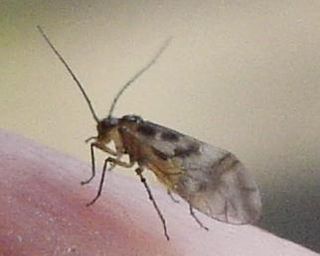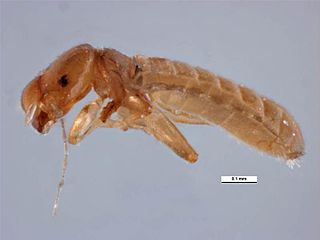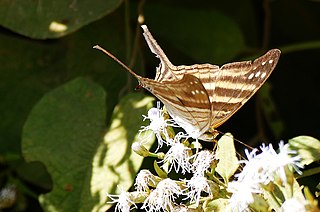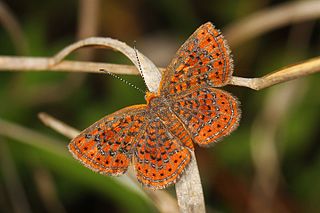
Convolvulaceae, known commonly as the bindweed or morning glory family, is a family of about 60 genera and more than 1,650 species of mostly herbaceous vines, but also trees, shrubs and herbs, and also including the sweet potato and a few other food tubers.

Psocoptera are an order of insects that are commonly known as booklice, barklice or barkflies. They first appeared in the Permian period, 295–248 million years ago. They are often regarded as the most primitive of the hemipteroids. Their name originates from the Greek word ψῶχος, psokhos meaning gnawed or rubbed and πτερά, ptera meaning wings. There are more than 5,500 species in 41 families in three suborders. Many of these species have only been described in recent years.

Nyctaginaceae, the four o'clock family, is a family of around 33 genera and 290 species of flowering plants, widely distributed in tropical and subtropical regions, with a few representatives in temperate regions. The family has a unique fruit type, called an "anthocarp", and many genera have extremely large pollen grains.

Liposcelididae is a family of booklice (Psocoptera) belonging to the suborder Troctomorpha. Members of this family are small and flattened, and often wingless.

Liposcelis bostrychophila is a species of booklouse in the family Liposcelididae. It is known nearly worldwide as a common pest of stored products. It is especially prevalent in cereals. It has been recently (2019) identified as a predator of mosquito eggs in a mosquito mass production facility.

Liposcelis is a genus of insects in the order Psocoptera, the booklice and barklice. There are about 126 species. Many species are associated with human habitation and several are well known as pests of stored products. The genus is distributed nearly worldwide.
Liposcelis ornata is a species of booklouse in the family Liposcelididae. It is found in Central America, North America, and South America.
Liposcelis deltachi is a species of booklouse in the family Liposcelididae. It is found in Central America and North America.

Lycaena editha, known generally as the Edith's copper or great gray copper, is a species of copper in the butterfly family Lycaenidae. It is found in North America.
Polygonus savigny, or Manuel's skipper, is a species of dicot skipper in the butterfly family Hesperiidae. It is found in North America.
Liposcelis entomophila is a species of booklouse in the family Liposcelididae. It is found in Africa, Australia, the Caribbean Sea, Europe & Northern Asia, Central America, North America, South America, and Southern Asia.

Proteides mercurius, the mercurial skipper, is a species of dicot skipper in the butterfly family Hesperiidae. It is found in the Caribbean Sea, Central America, North America, and South America.

Marpesia chiron, the many-banded daggerwing, is a species of daggerwings, map butterflies in the family Nymphalidae. It is found in Central America, North America, and South America.

Cabares potrillo, the potrillo skipper, is a species of dicot skipper in the butterfly family Hesperiidae. It is found in the Caribbean Sea, Central America, North America, and South America.
Aradus funestus is a species of flat bug in the family Aradidae. It is found in North America.

Calephelis virginiensis, the little metalmark, is a species of metalmark in the butterfly family Riodinidae. It is found in North America.
Aradus depictus is a species of flat bug in the family Aradidae. It is found in North America.

Polygonus leo, the hammock skipper, is a species of dicot skipper in the butterfly family Hesperiidae. It is found in the Caribbean Sea, Central America, North America, and South America.

Electrostrymon angelia, the fulvous hairstreak, is a species of hairstreak in the butterfly family Lycaenidae. It is found in North America.
Cyanophrys miserabilis, known generally as the Clench's greenstreak or miserabilis hairstreak, is a species of hairstreak in the butterfly family Lycaenidae. It is found in North America.












